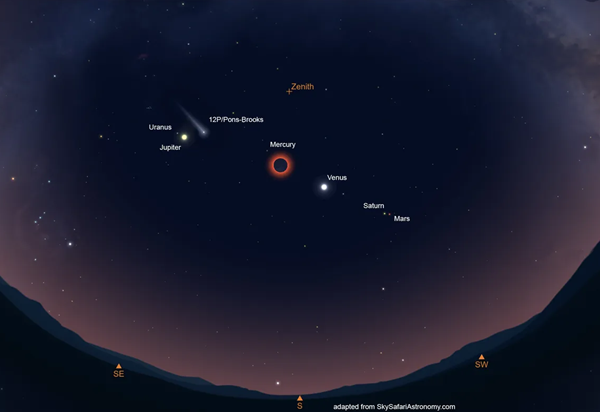
(Editor’s note: This article was first published in 2023 and has been updated.)
On April 8, 2024, all eyes will be on the eclipsed Sun during totality. After all, it’s the main attraction.
But as the Sun is blotted out, darkness will fall during the day, rendering more than just the solar corona visible in the sky. Stars and planets will appear, lighting up amid the false twilight that occurs during a total eclipse. Several of the brightest stars and planets will come into view — and one special visitor: Comet 12P/Pons-Brooks
That’s right. Bring your binoculars along during the total solar eclipse on April 8, 2024, and you might be able to catch a comet hovering in the sky near the eclipsed Sun.
The discovery of Comet Pons-Brooks
Amateur astronomer, astrophotographer, and longtime comet-lover Dave Weixelman from Nevada City, California, discovered that Comet Pons-Brooks would be near the eclipsed Sun during totality of the 2024 total solar eclipse.
Related: The so-called ‘Devil comet’ is headed our way — and that’s OK
Weixelman tells Astronomy he knew that Pons-Brooks would be reaching perihelion in 2024 as a possible naked-eye comet. So one day, he plotted the comet’s location at the date and time of the eclipse using the SkySafari software, setting the viewing location inside the path of totality in southern Texas.
That’s when he saw that Comet Pons-Brooks will be located near Jupiter and some 24.5° from the eclipsed Sun. This means the comet will be potentially visible at mid-eclipse to those searching with binoculars or a telescope, or capturing the scene with a camera.
12P/Pons-Brooks has a period just over 70 years. April 8, the date of the 2024 eclipse, is just two weeks before the comet reaches perihelion, the closest point to the Sun in its orbit. On April 8, Comet Pons-Brooks will sit about 1.61 astronomical units from Earth, or nearly 150 million miles (240 million kilometers), on the opposite side of the Sun from our planet. (1 astronomical unit is the average Earth-Sun distance.) This will be near the time it reaches peak brightness, as it won’t come much closer to Earth even after it approaches and rounds the Sun.
How to see Comet Pons-Brooks
Six planets will be in the sky during totality of the 2024 solar eclipse. Venus will be the brightest at magnitude –3.9, located about 15° southwest of the Sun. On the opposite side of our star some 30° northeast of the Sun will be the second brightest planet, magnitude –2 Jupiter.
Jupiter will serve as a convenient guidepost to find Comet Pons-Brooks, says Weixelman, as the comet will lie just 6° west of Jupiter and about 24.5° northeast of the Sun. That puts Pons-Brooks in roughly the same binocular field of view as the gas giant, upping the ease with which searchers might find it.
Although the viewing geometry between Earth and the comet isn’t ideal during its eclipse apparition, current predictions suggest that Pons-Brooks will appear around 5th magnitude. However, comets are fickle creatures and predictions can fall far from the mark in either direction. But assuming Pons-Brooks behaves as expected, “depending on the actual brightness of the comet during the eclipse, the comet may or may not be visible in binoculars,” says Weixelman.
An experienced astroimager himself, Weixelman notes that photographers will naturally be excited for the unique opportunity to capture both the solar corona and the comet during totality of the 2024 solar eclipse. After all, it’s rare (though not unheard of) for comets to peek out of the daytime darkness that only a solar eclipse can bring.









